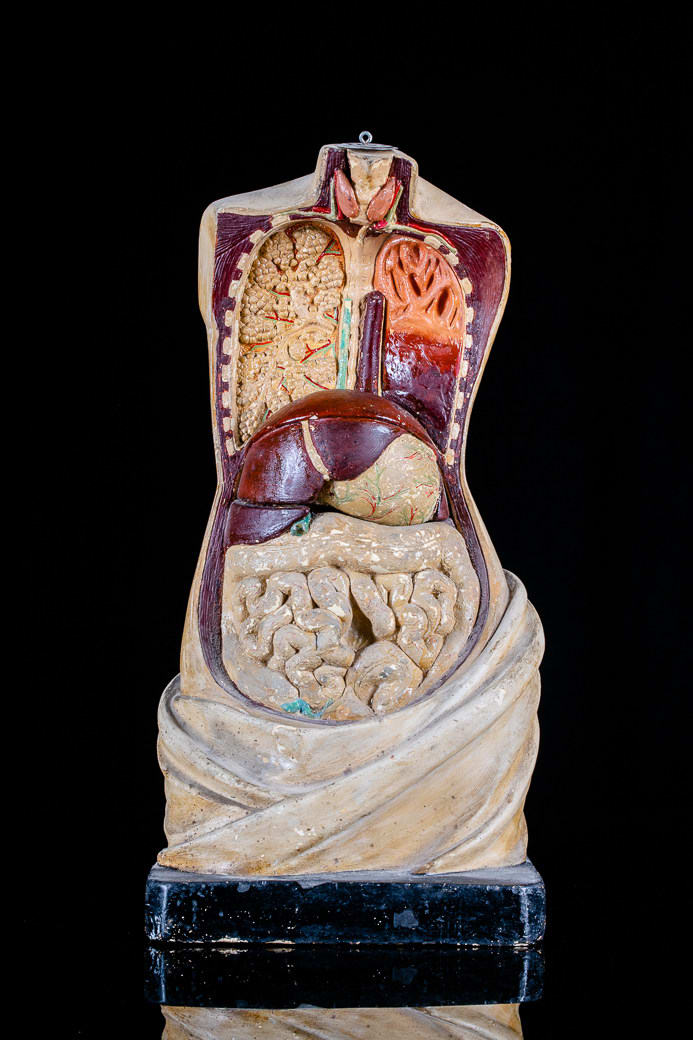Anatomical Didactic Model of a Torso with Removable Organs by Franz Jozef Steger and Prof. Wilhelm His
19-20th Century
Plaster
60 x 30 x 23 cm
23 5/8 x 11 3/4 x 9 in
23 5/8 x 11 3/4 x 9 in
1942
Sold
Further images
The German sculpture Franz Josef Steger (1845-1938), under the guidance of Professor Wilhelm His (1831-1904) and based on the designs of anatomist Carl Ernst Bock (1809-1874), revolutionized anatomical models in the 1880s by developing a fast and accurate method of producing plaster-cast models. This was partly based on the suggestion of Prof. His that the body parts be frozen before dissection and casting, which prevented movement of the body parts and organs and allowed a more natural placement of the muscles, organs, and bones, thus creating a more realistic model. The Steger plaster-casts were produced from the late 1880s until the early 1930s. This specific Bust dates from the 1890s carry a maker's label on the base and show only small damages and no restorations. Anatomical models have been used for centuries as an adjunct to teaching anatomy and play an important role in the history of anatomical education. In addition, models became popular for such reasons as the public disapproval of grave robbery.
La sculpture allemande Franz Josef Steger (1845-1938), sous la direction du professeur Wilhelm His (1831-1904) et en se basant sur les dessins de l'anatomiste Carl Ernst Bock (1809-1874), a révolutionné les modèles anatomiques dans les années 1880 en développant une méthode rapide et précise de production de modèles en plâtre moulé. Cela reposait en partie sur la suggestion du professeur His de congeler les parties du corps avant la dissection et le moulage, ce qui empêchait le mouvement des parties du corps et des organes et permettait un placement plus naturel des muscles, des organes et des os, créant ainsi un modèle plus réaliste. Les moulages en plâtre de Steger ont été produits du fin des années 1880 jusqu'au début des années 1930. Ce buste spécifique date des années 1890 et porte une étiquette du fabricant sur la base, il ne présente que de légers dommages et aucune restauration. Les modèles anatomiques sont utilisés depuis des siècles comme complément à l'enseignement de l'anatomie et jouent un rôle important dans l'histoire de l'éducation anatomique. De plus, les modèles sont devenus populaires pour des raisons telles que la désapprobation du public envers le vol de cadavres.
La sculpture allemande Franz Josef Steger (1845-1938), sous la direction du professeur Wilhelm His (1831-1904) et en se basant sur les dessins de l'anatomiste Carl Ernst Bock (1809-1874), a révolutionné les modèles anatomiques dans les années 1880 en développant une méthode rapide et précise de production de modèles en plâtre moulé. Cela reposait en partie sur la suggestion du professeur His de congeler les parties du corps avant la dissection et le moulage, ce qui empêchait le mouvement des parties du corps et des organes et permettait un placement plus naturel des muscles, des organes et des os, créant ainsi un modèle plus réaliste. Les moulages en plâtre de Steger ont été produits du fin des années 1880 jusqu'au début des années 1930. Ce buste spécifique date des années 1890 et porte une étiquette du fabricant sur la base, il ne présente que de légers dommages et aucune restauration. Les modèles anatomiques sont utilisés depuis des siècles comme complément à l'enseignement de l'anatomie et jouent un rôle important dans l'histoire de l'éducation anatomique. De plus, les modèles sont devenus populaires pour des raisons telles que la désapprobation du public envers le vol de cadavres.
Provenance
European Private CollectionJoin our mailing list
* denotes required fields
We will process the personal data you have supplied in accordance with our privacy policy (available on request). You can unsubscribe or change your preferences at any time by clicking the link in our emails.











